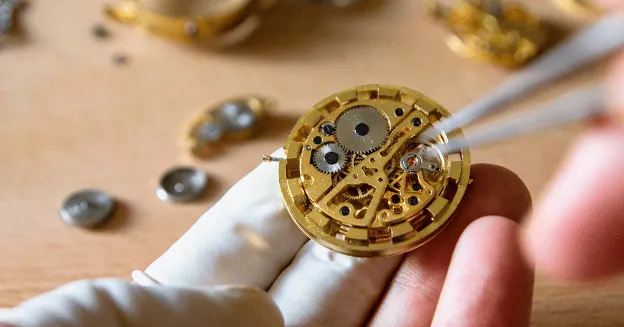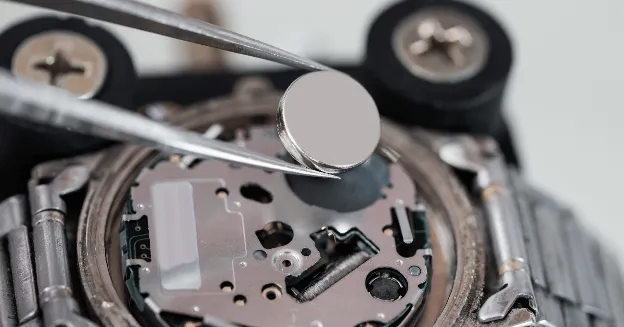Movement Types in Watches

-
Movement Types in Watches
-
Mechanical Movement
- Crown
- Mainspring
- Gear Train
- Escapement
- Balanced Wheel
- Dial Train
- Jewels
-
Automatic Movement
- Crown
- Mainspring
- Gear Train
- Escapement
- Balanced Wheel
- Dial Train
- Jewels
-
Quartz Movement
- Battery
- Integrated Circuit
- Quartz Crystal
- Stepping Motor
- Dial Train
-
Which Movement Suits You?
Watches are beautiful pieces of art. They are also symbols of class, power, and prestige. The main function of a watch is to tell time. Watches can tell what time it is by reading the time on its face or by using an inner mechanism called a movement. This article explores the different types of movements so you can find which one will suit your needs best!
Movement Types in Watches
What makes a watch "move" is its movement. For the most part, watchmakers buy their movements in whole or in parts from other firms. Only a small number of businesses are really "vertically integrated," meaning they operate entirely on their own and don't rely on outside suppliers for anything. Manufacturers are the firms that create these timepieces, which are more costly and in great demand due to their rarity.
Mechanical Movement
Since the 16th century, the oldest form of watch movement has been a mechanical movement, sometimes known as a hand-wound mechanism. It has to be winded every day in order to function. Typically, mechanical movements may be found in more conservative, costly, and collectable timepieces.
A top-tier piece of machinery in the realm of mechanics is anything made up of tiny components and capable of sustaining a precision level of 99 percent. One minute and 27 seconds each day is unacceptable in the luxury watch industry if a watch is just 99.9 percent accurate.
The mechanical movement's parts are as below.
Crown
The time is set using the little wheel on the side of the watch, the crown. It may also be used to wind the watch and get it going.
Mainspring
Movement's primary source of energy. Winding the crown releases kinetic energy, which is then transmitted to the mainspring's coils, which tighten and tighten.
Gear Train
Using a sequence of tiny gears, the gear train transmits the accumulated energy from the mainspring to the escapement.
Escapement
As a brake, the escapement dissipates the energy received from the mainspring and distributed evenly across the gear train.
Balanced Wheel
Energy from the escapement powers the movement's heart. The balancing wheel oscillates between five and 10 times a second in a circular motion. By adjusting the balance wheel's frequency of rotation, a watchmaker may modify how quickly or slow the timepiece ticks.
Dial Train
The dial train is a set of gears that connects the balance wheel and the watch's hands, allowing the watch's hands to move in unison.
Jewels
Synthetic rubies are put in high-friction areas, such as the hub of a gear that's always turning. They increase performance and accuracy by reducing metal-to-metal friction and wear. The high thermal conductivity and exceptional hardness of rubies make them ideal for this use.
Automatic Movement
A self-winding mechanical movement known as an automatic movement, which was originally introduced in the early 20th century. No need to bother about daily winding since it does it for you. After a long amount of time, the watch will stop operating and must be wound manually. It is advised to wear your watch to bed.
Rotors on automatic watches are coupled to the movement so that when you move your wrist, the rotor spins and tightens the watch's mainspring. This happens secretly throughout the day without you even realising. Wearing it and moving around such as walking, doing everyday activities, and such, will automatically wind the watch.
Standard self-winding movements have an accuracy of +/-25 seconds each day, which means that over the course of two days, they should only gain or lose 25 seconds. Because of this, ordinary automated motions are 99.97% accurate.
The automated movement's components are as follows.
Crown
The crown, a little wheel on the side of the watch, is used to set the time. In addition to winding the watch, it may also be used to get it started.
Mainspring
Power comes from the movement itself. Kinetic energy from the crown is conveyed to the mainspring coils by winding the crown.
Gear Train
Transmission of stored energy between the mainspring and escapement occurs through a gear train composed of a series of very small gears.
Escapement
This releases the energy from the mainspring, which has been spread equally throughout the gear train, via the escapement.
Balanced Wheel
It is the escapement that provides the movement's core with its force. There are between five and ten oscillations of the balance wheel each second. A watchmaker may alter the timepiece's tick rate by changing the balance wheel's rotational speed.
Dial Train
The balancing wheel and the watch hands are connected by the dial train, which is a system of gears.
Jewels
The hub of a gear that's continually spinning is a good place to insert synthetic rubies. Metal-to-metal friction and wear are reduced, resulting in improved performance and precision. Rubies are an excellent choice because of their great heat conductivity and extreme hardness.
Quartz Movement
There is no winding required with the quartz mechanism, unlike mechanical watches. As far as mechanical movements go, this one is the most precise presently available.
Compared to mechanical wristwatches, modern quartz/battery-powered timepieces are typically more accurate. Quartz watches are normally accurate to within a second or two of each other every day. Quartz watches, in contrast to mechanical timepieces, are impervious to variations in gravity, tolerances, and lubricants, all of which may affect the precision of the timekeeping.
The components of a quartz movement watch are listed below.
Battery
This is the watch's power source, similar to a mechanical watch's mainspring. A quartz watch's battery typically lasts from 12 months up to 10 years depending on the battery and watch before it has to be replaced. In order to prevent the battery from leaking acid and ruining the movement, it is essential to replace it immediately after its death.
Integrated Circuit
As the name implies, this conducts electricity from one area of the quartz movement to the next.
Quartz Crystal
Equivalent to a mechanical watch's balance wheel. The quartz crystal receives a steady supply of power from the integrated circuit. In the presence of electricity, quartz vibrates and produces voltage.
Stepping Motor
Mechanical power is generated by converting electrical impulses into mechanical energy.
Dial Train
Like the dial train on a mechanical movement, it performs the same functions.
Which Movement Suits You?
Some important factors to consider while choosing the best watch for you. As you can see, various watch movements demand varying amounts of care and maintenance from the user.
Your tolerance for watch care may vary depending on your degree of involvement in watch-wearing as a passion and habit. Mechanical watches demand the greatest care and attention from the wearer since they must be wound manually to keep operating. Many people like the process of caring for and wearing a mechanical watch.
An automatic watch is a good option if you want a mix of heritage and modernity. The traditional mainspring mechanism is still used in automatic timepieces. One of the most enticing features of an automatic watch is its weight.
Quartz movement is the way to choose if you want a watch that is simple to maintain. Unobtrusive and attractive, quartz watches go with any ensemble. Quartz watches save time and energy for guys with hectic schedules.
If you find this article helpful, you might want to check out my other posts :
>> Different Types of Watch Materials
>> Top 3 Commonly Used Materials for Watch Glasses
To learn more about watches :
>> Welcome to Our Learning Hub
To see my recommendations of watches, cases, and watch straps :
>> Explore Watches and More with TimeFAQ!
To see my reviews of watches :
-
Movement Types in Watches
-
Mechanical Movement
- Crown
- Mainspring
- Gear Train
- Escapement
- Balanced Wheel
- Dial Train
- Jewels
-
Automatic Movement
- Crown
- Mainspring
- Gear Train
- Escapement
- Balanced Wheel
- Dial Train
- Jewels
-
Quartz Movement
- Battery
- Integrated Circuit
- Quartz Crystal
- Stepping Motor
- Dial Train
-
Which Movement Suits You?



